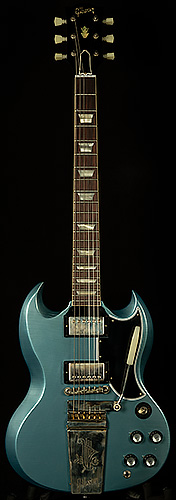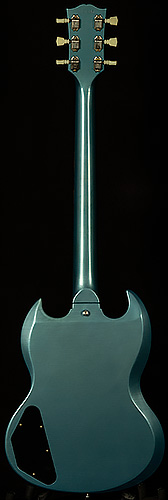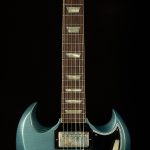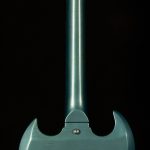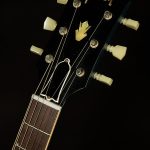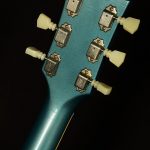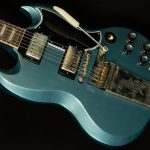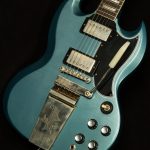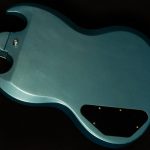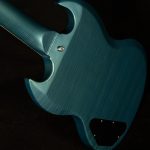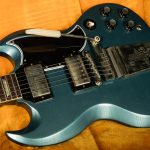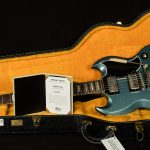Gibson Murphy Lab 1964 SG Standard Reissue – Ultra Light Aged, Maestro Vibrola
The Marvels of the Murphy Lab
There are 7.764 billion people on this beautiful ball of water and dirt that we call home, and hardly any of them know Gibson guitars better than Tom Murphy. Tom is a legend in the world of guitars, and instruments bearing his name have acquired a deservedly sterling reputation due to their outstanding tone, jaw-dropping looks, and stunning vintage accuracy. But, he wasn't always a rockstar of lutherie. In fact, he worked as a professional touring musician for many years, and during that time he became intimately acquainted with vintage guitars: how they sound, how they feel, and how they look. After deciding to stop touring, Tom got a job as a finish specialist at Gibson and eventually became a project manager in charge of the first reissues of the 1959 Les Paul standard.
For a while, Tom also gained valuable experience working as a luthier to the stars, and his client list included luminaries like Jimmy Page, Dickey Betts, Joe Perry, Billy Gibbons, Eric Clapton, Peter Frampton, and Gary Rossington.
Now, things have come full circle, and our friends at Gibson have handed Tom the keys to a brand-new institution of sonic savagery within the Gibson Custom Shop: the Murphy Lab. Tom and his team of skilled craftspeople have one mission, and one mission only: to create the most ridiculously awesome recreations of vintage Gibson guitars that the world has ever seen.
Step Into the Lab
Murphy Lab is aptly named because it is basically the musical equivalent of what happens when you give a mad scientist a laboratory fully stocked with warp drives and flux capacitors. With a plethora of resources behind them, Tom and his team have been able to create guitars that are essentially carbon copies of vintage Gibsons. They look, feel, and sound so close to the originals that it's downright scary.
How do Tom and his team achieve such unparalleled vintage accuracy? Well, first off, Tom has discovered a brand-new formula for nitrocellulose lacquer to use on aged guitars that mimics the properties of 1950s and ‘60s finishes to a T. Thanks to this thinner finish, aged Murphy Lab guitars look like authentic vintage pieces. They don’t just look the part--they are the real McCoy!
Of course, the heart of the Murphy Lab is the aging process. Part of what made Tom a legend was his ability to replicate the natural wear and tear found on distressed vintage instruments by hand-aging brand-new instruments. With his practiced eye and skilled hands, Tom artfully mimicked the finish and feel of old guitars, and he has imparted his skills to the talented team at the Murphy Lab.
Though Tom may not age each and every guitar himself, he has done a bang-up job of teaching his team the Way of Murphy, and they do a marvelous job of replicating his masterful work. As a result, each guitar looks like it came out of a time machine and feels like your favorite worn-in pair of blue jeans.
Born Under a Bad Sign
Back in 1961, the folks at Gibson decided it was time to refresh and re-imagine the Les Paul, and boy did they ever hack and slash! In order to freshen things up, they did away with the maple top and the sunburst finish. Instead of Les's design, they presented Mr. Paul with a sleek, contoured horned devil made out of lightweight mahogany. 'Ol Les was NOT pleased and asked them to kindly take his name off the truss rod cover. This left the Gibson marketing team in a bit of a lurch, so they scrambled to find a name for their new ax and landed on "Solid Guitar."
After its inauspicious birth, the SG did indeed prove itself to be a Solid Guitar in every sense of the word (who knows, maybe the SG works so well for rock and roll because it was born under a bad sign--it does have horns, after all!). Its aggressive styling and muscular tone quickly made it a favorite of a whole host of guitarists from Angus Young to Pete Townshend to Tony Iommi to Dickey Betts. When you step back and think about it, it's pretty wild that the dude from Black Sabbath played the same guitar as the dude in the Allman Brothers! A staggering amount of players in many genres have made classic records using an SG. The length and breadth of the list of SG aficionados is a testament to its incredible versatility and universal appeal.
Specifications:
| Brand | Gibson Murphy Lab |
|---|
| Model | 1964 SG Standard Reissue with Maestro |
|---|---|
| Finish Color | Pelham Blue |
| Finish Type | Murphy Lab Ultra Light Aged Nitrocellulose Lacquer |
| Limited Series | 7.84 lbs. |
| Body Wood | Solid Mahogany without Weight Relief |
| Neck Wood | Solid Mahogany |
| Neck Joint | Long Tenon Secured with Hot Hide Glue |
| Neck Shape | Medium C |
| Neck Dimensions | .890 1st - 1.000 12th |
| Fingerboard | Indian Rosewood |
| Inlays | Cellulose Nitrate Trapezoids |
| Scale Length | 24.75" |
| Width at Nut | 1.687" |
| Nut Material | Nylon |
| Frets | 22 Authentic Medium-Jumbo |
| Hardware | Murphy Lab Light Aged Nickel |
| Pickups | 2 Custombucker Alnico 3 (Unpotted) |
| Controls | 2 Volume, 2 Tone, 3-Way Selector Switch; CTS 500K Audio Taper Potentiometers, Black Beauty Capacitors |
| Bridge | ABR-1 |
| Tailpiece | Maestro Vibrola |
| Saddle | Nickel-Plated Brass |
| Tuners | Kluson Single Line, Double Ring |
| Pickguard | Multi-ply Black |
| Case | Gibson Custom Shop Black Lifton Reissue 5-Latch Hardshell with Yellow Interior |
| COA | Yes |
Why Order from Wildwood Guitars?
An instrument from Wildwood isn't just an ordinary guitar. It's your guitar. Each and every instrument we sell includes a full, point by point setup, an exhaustive evaluation, and expert shipping procedures, with first class, industry leading standards from start to finish. Why? Because you deserve it.Click Here to learn more about what makes a Wildwood instrument so special...



